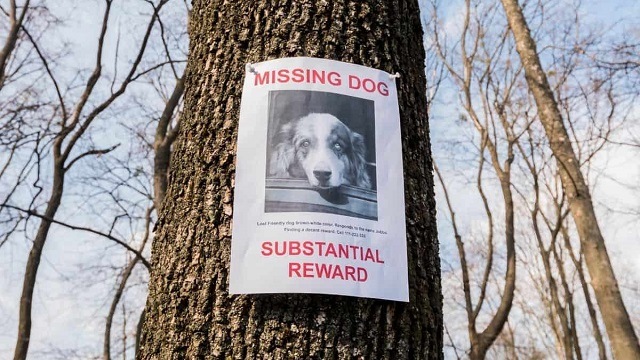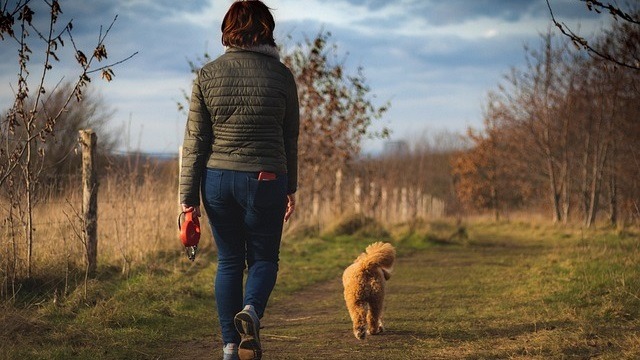You wake up in the morning and there’s no trace of your furry friend… Oh no, they’ve escaped! Need an emergency plan? Here’s how to find a lost dog!
Before you get started, remember: try to remain calm, but at the same time, to be as fast as you can. The quicker you are, the higher the odds of finding your buddy safe. Even if both you and your dog are already experts in this “lost and found” stuff, be proactive and do not just passively wait for them to return home.
Bear in mind that your phone should always be with you, especially if your pup has a microchip. If anyone finds them, they can use the contact information to reach you.
How to find a lost dog, step by step

- Search your neighborhood. You can start by going for a quick walk, carrying a recent photo of your dog with you to show any passers-by, and a bag of treats in case you need to lure your buddy. Ask people who have bonded with your dog before to help you out. If the first hour passes and you have had no luck, get a car and drive around so you can cover a wider area.
- Make sure someone stays home. It should be someone with whom your dog has a bond, too. This is just in case your buddy returns while you are out looking for them.
- Make a “lost dog” flyer. Make it appealing, use a clear photo of your buddy and hang it in busy places. Promising a reward is also an effective tactic.
- Call and visit local vets. Notifying them that your dog is missing and leaving a flyer can make the difference.
- Visit local dog shelters and animal control centers. Do not rely only on phone calls and the “lost dog” poster. After declaring your buddy as a missing dog, pay them a visit every two days and ask to check the found dogs. Bring a picture and all of your dog’s documentation with you.
- Search the web. The internet can be a big help regarding how to find a lost dog. Use social networks and encourage people to share a post about your missing pet. Local lost-and-found pet groups are very useful too!
- Advertise in the newspaper or radio. Even if it seems outdated, putting an ad in the local newspaper or even making a public announcement on the radio can be helpful.
How far can a dog go?

There is no golden rule for that… But the dog’s temperament and the motif for getting lost highly impact how far away a dog might go. Friendly pooches usually do not go far, as they will easily approach people. On the other hand, the ones who are wary of strangers or scared of anything that is unfamiliar, will keep their distance and will be more difficult to catch.
Getting lost in an open landscape versus in a residential area, or in a crowded city versus a rural environment, also influences how far a dog may travel. Buildings, traffic and people make the experience more dangerous and likely traumatic, but they also work as physical barriers This inhibits your dog and causes them to just wander around.
3 main reasons why dogs get lost

Whether because they are wandering around and lost track of their human, or because something scared the hell out of them, the end result can be the same: getting lost.
- Opportunity. A fence wrongly locked or a door left open, make the perfect setting for an opportunistic fellow to run away. It says nothing about your qualities as a dog parent, though. You just have to be extra careful if your dog is like this!
- Wanderlust. Some dogs just have a strong drive to travel, and they will almost always find a way to break free. Hounds and intact males are much more likely to be wanderers.
- Blind panic. It cannot get trickier than this. The triggers that can frighten the life out of a dog are many and varied, like thunderstorms and fireworks. It all depends on the dog’s previous experiences and possible traumas. Terrified pooches are the ones most difficult to find, because they not only get bewildered, but also tend to get scared of everyone… Including their owners.
Take the lead and be proactive in case your buddy gets lost. Consider the context in which it happens and your dog’s temperament, so you can know what to expect in terms of paved distance.
Essentially, do not lose hope – even if you’ve done all of the above and there’s still no sign of your faithful companion. There have been cases of dogs finding their way home years after running away, even against all the odds. Keep your efforts up, and do not let the negativity creep in!
Maven is all about proactive pet care. Be your best friend’s best friend by giving them 24/7, high-quality, industry-leading vet care to improve their mental health, physical health and more. No more frantic googling or unneeded stressful visits to the vet – Maven helps you save hundreds while also ensuring your pet lives the best life possible. Get your kit now!



